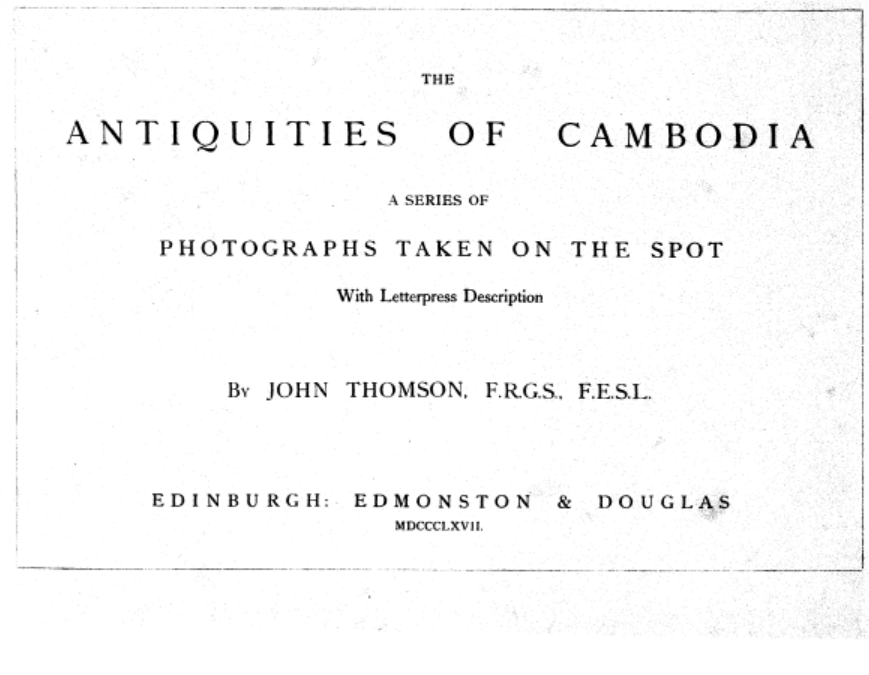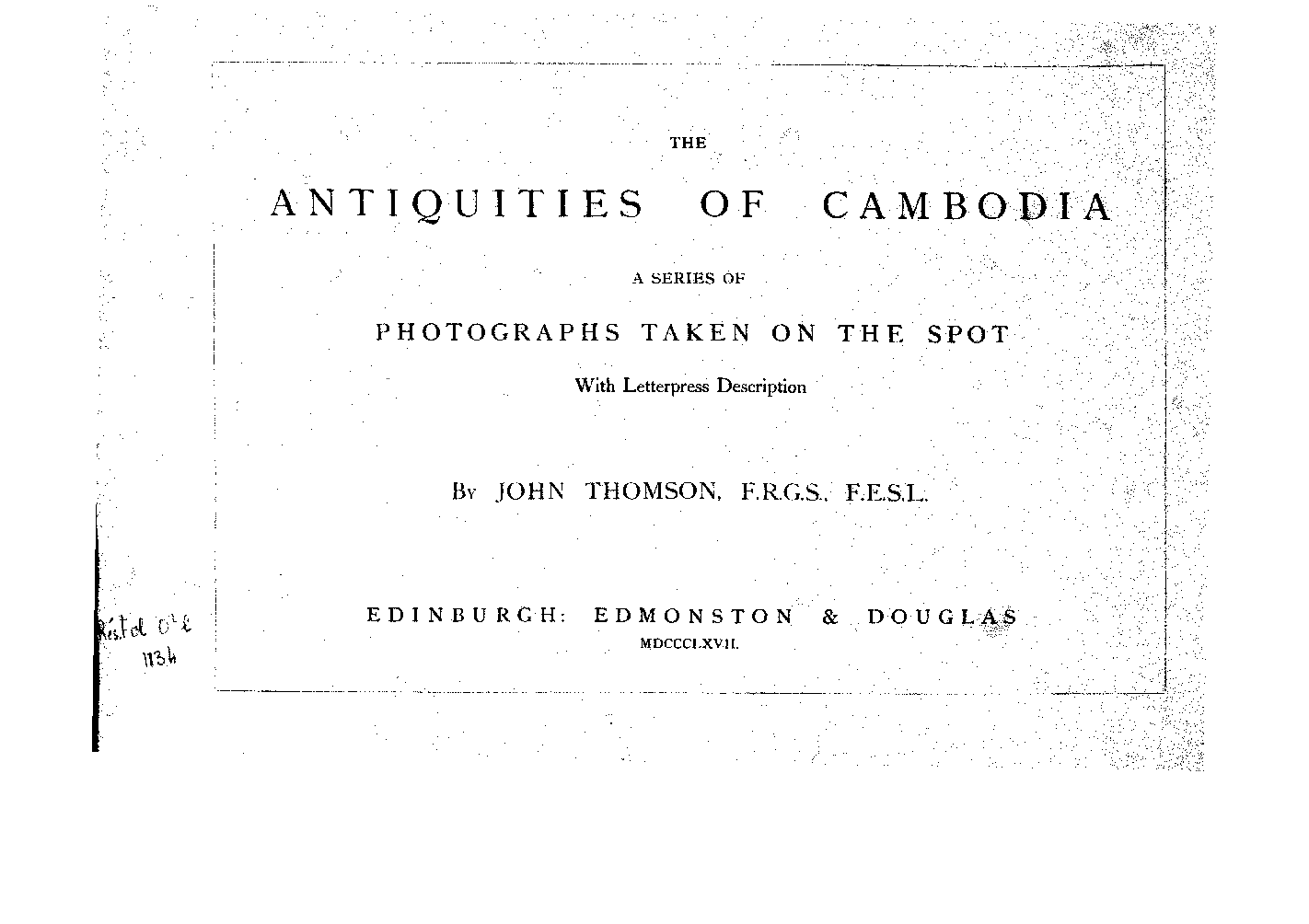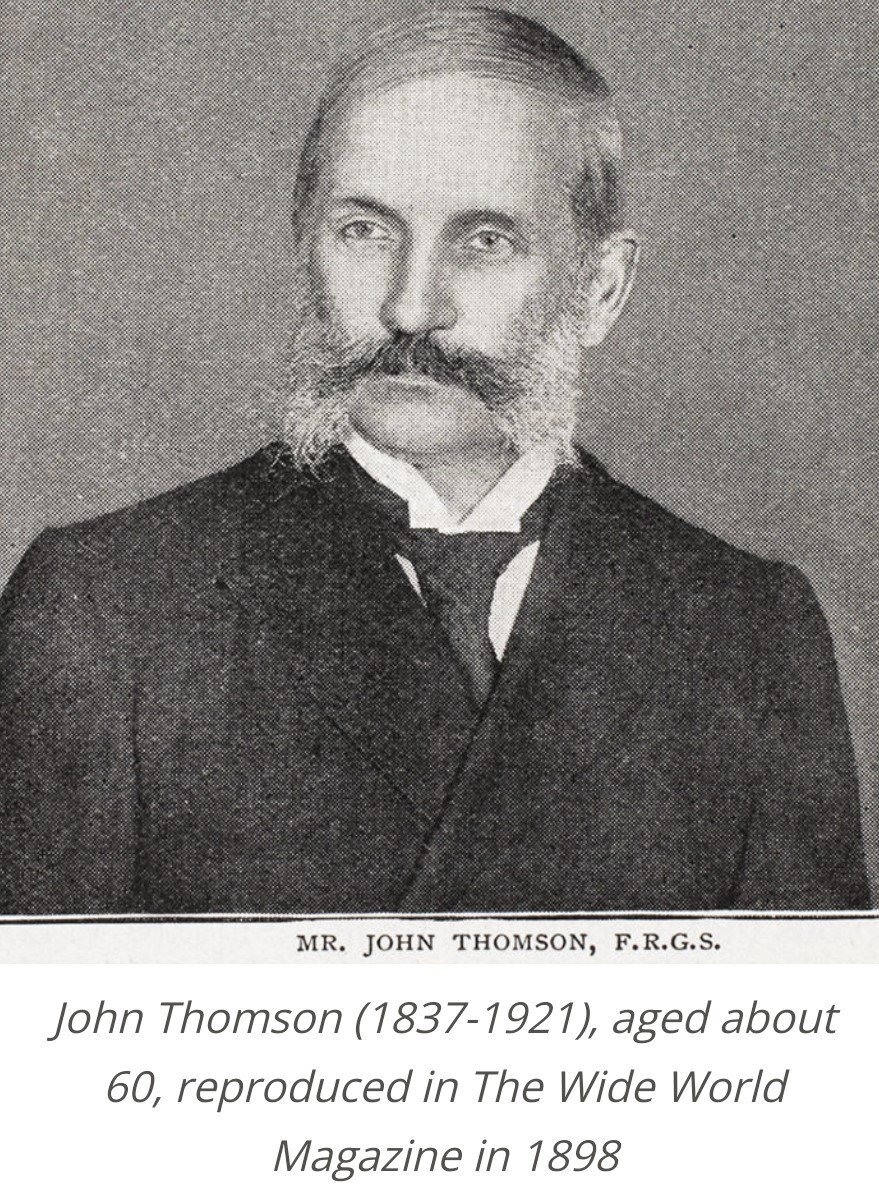The Antiquities of Cambodia
by John Thomson
Was he "the first" or "one of the first" to rediscover Angkor and to capture it on film? No matter what, John Thomson's testimony remains priceless.

- Format
- e-book
- Publisher
- Edmonston & Douglas, Edinburgh
- Edition
- Source: gallica.bnf.fr/ Bibliotheque Nationale de France
- Published
- 1867
- Author
- John Thomson
- Pages
- 73
- Language
- English
pdf 6.4 MB
With a warm tribute to Henri Mouhot in the very first sentences, John Thomson’s book reflects not only the photographer’s skills but also the keen eye of the geographer — one has to keep in mind he was a member of the Royal Geographical Society for no less than fifty-five years.
In his introductory note to this Series of Photographs Taken on the Spot, the author remarks:
Cambodia is one of the most fertile and beautiful of the tropical countries of S.-E. Asia. It is bounded on the N.N.-W., and W. by Anam, Laos, and Siam; on the S. by the Gulf of Siam and E. by Lower CochinChina. Like Egypt Cambodia possesses a great fertilizing agency in the annual inundation of the Mekong River, which flows through the country from an unknown source in the south of China.
At present the cultivation of rice, cotton, silk, pepper, tobacco, and other products is confined to a small radius round the towns and villages scattered along the banks of the river, or of the Tale-Sap (a great fresh-waterlake). When the country was in its glory the interior must have been a perfect garden. It is now covered with vast prairies and impenetrable forests. Scattered in handfuls round the outskirts of these forests, where the elephant, the rhinocéros, and the tiger abound, the rude natives, who live in the most primitive fashion, gain their subsistence by collecting gums, cardimums, ivory, horns,and hides.
Native tradition, the annals of the surrounding nations, the ancient stone cities, the bridges that span the rivers, and the highways that intersect the plains, tell us that the ancient Cambodians were a powerful and cultivated race, whose influence extended far and wide, and who spared no labour or wealth in developing the resources of their vast dominions. For at least 500 years Cambodia has been on the decline,and its territory bas undergone a process of gradual absorption by the surrounding nations. Oniy eighty-four years ago the provinces in which its finest antiquities are found were ceded to the Siamese (see King of Siam’s letter), and the entire country was tributary to Siam up to August 1863, when, by a French treaty with the Siamese, Cambodia was rendered an independent kingdom.
While the present book only dwells on the architectural and archaeological aspects of his exploration, we find interesting notations about the technical constraints the “traveller-photographer” had to face in his daily work in the remarks Thomas made following George Curzon’s communication to the RGS in 1893, “Journeys in French Indo-China (Tongking, Annam, Cochin China, Cambodia”):
When in Cambodia, the King of Siam sent a special envoy to request me to photograph the entire series, a request with which I was unable to comply. At that time the kodak was unknown, and one had to depend on the collodion wet process of photography. This entailed the constant presence of eight or ten porters to transport the necessary apparatus. But the process had this advantage; as each plate was taken it was at once developed, so that one could see and judge of its value.” (see full text here).
Among the spots photographed and commented:
- Angkor Wat (Nakhon Wat) galleries and entrances, bas-reliefs. About the latter, he notes that “the skill displayed in these bas-reliefsgoes far to prove that Nakhon Wat was erected during the reign of a Cambodian Semiramis, when the wealth and resources of the country must have been equal, if not supenor, to that of the ancient Egyptians, and when the Cambodians,one would conceive, must have been a nation of skilled workmen.”
- Angkor Thom (Nakhon Thom “or Inthapatapuri”);
- Bayon: which Thomson quite poetically calls “Prea Sat Ling Poun (the place where they play hide-and seek), a modern name given by the natives on account of the labyrinth of passages and apartments that occur beneath the towers.” One cannot be but impressed by the accuracy of the photographer’s captions, as in effect លេងបិទពួន leng phuon means hide-and-seek in modern Khmer, a game still played by kids nowadays;
- Palace of the Leprous King (“Prasat Chow Ke-rhuen”): actually the Phimeanakas and the Elephant Terrace.
Further reading on John Thomson:
- John Thomson (1837−1921) photographer / Richard Ovenden ; foreword by Sir David Puttnam ; specialist photographic printing and a chapter by Michael Gray (White Lotus, Bangkok:2014)
- John Thomson : the early years : in search of the Orient / Joel Montague & Jim Mizerski (White Lotus, Bangkok:2014)
Tags: photography, Western explorers, 19th century, Siam, Angkor Wat, Angkor Thom, Bayon, Elephant Terrace, Royal Palace
About the Author

John Thomson
Scottish photographer and geographer John Thomson (14 June 1837, Edinburgh – 29 Sept. 1921, Edinburgh) was a pioneer in photographying the ruins of Angkor in 1866, part of his ten-year long travel stint across Asia after joining his elder brother William in Singapore in 1862.
When he left for the Far East, he had studied photography processing and technique as an apprentice in an optical and scientific device manufacturing company, while enrolling to evening classes at Watts Institution and School of Arts to study chemistry, philosophy and geography.
Thomson was welcomed at the Court of Siam in 1865, and then to Phnom Penh Royal Palace the following year. After Cochinchina and Indochina, he traveled around China, documenting local cultures, landscapes and artefacts of the East. He insisted to travel to Angkor, with the assistance of his friend H.G. Kennedy, a British Consulate officer fluent in Siamese, after reading Henri Mouhot’s travel accounts, first published in English even if Mouhot was a French citizen.
According to Jim Mizerski in Cambodia Captured, “On January 27, 1866, John Thomson accompanied by H. G. (Henry George) Kennedy left Bangkok on his way to Angkor. His departure was noted in the Bangkok Recorder:
Mr. Thomson, the photographer who has been residing in Bangkok approximately three months, departed last Saturday, 11th day of the waxing moon in the third month, headed for Cambodia, to the ancient city of Angkor, wishing to photograph those ancient artifacts for the European people to see. Mister Thomson went by land, not by way of Chanthaburi. He expects to return in two months. During those two months anyone wishing to see the photographs taken in Bangkok may do so. The photographs are with Captain Ames, Commander of the Police, whose home is at Pom Pongpajamid. The king praised Mr. Thomson as a truly excellent photographer. I agree that none can compare to him.
In The Straits of Malacca, John Thomson recorded the start of his Cambodian adventure:
We had first intended to sail down the Gulf of Siam to Chantaboon, and thence to cross over the forest-clad mountains of that province to Battabong. But the Siamese Government declined to grant a passport for that route, which they reported as dangerous and impracticable. We were therefore reduced to the necessity of making a tedious, and, so far as health was concerned, more dangerous journey by the creeks and rivers, and across the hot plains and marshes of the south-eastern provinces of the interior.
Thomson’s original plan to follow a shortened version of Henri Mouhot’s route was not possible and his adventure in Cambodia was to be uniquely his own. There is nothing to suggest that Thomsen’s plan, at least at the time he left Bangkok, included traveling to Phnom Penh and Kampot, which he later did.
After his Asian period, he worked on the street people of London, deveoping a style of social documentary viewed as the historic basis of modern photojournalism. Yet he was at ease in all strata of society, to the point that he became portrait photographer of the Mayfair High Society, with a Royal Warrant granted to him in 1881. He had a great impact on his contemporaries, for instance introducing the famous travel writer Isabella Lucy Bird to the art of photography.
See the short online biography by the National Library of Scotland.



